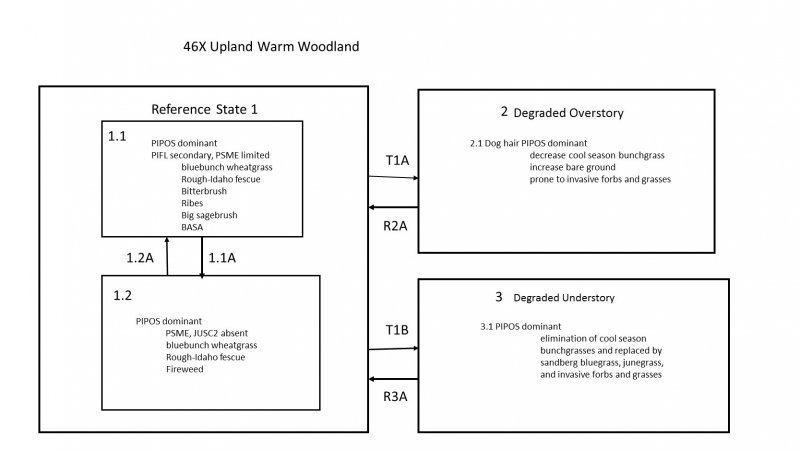
Natural Resources
Conservation Service
Ecological site F046XP911MT
Upland Warm Woodland Group
Last updated: 9/07/2023
Accessed: 12/21/2025
General information
Provisional. A provisional ecological site description has undergone quality control and quality assurance review. It contains a working state and transition model and enough information to identify the ecological site.
MLRA notes
Major Land Resource Area (MLRA): 046X–Northern and Central Rocky Mountain Foothills
The Provisional ESD Initiative was established to expedite the development of ecological site descriptions through the development of provisional ESDs. While Provisional ESDs are not complete, the intent is to produce an ESD complete enough for land managers to use while approved ESDs are being developed. This project area has mixed ownership falling primarily under private ownership or lands managed by the Blackfeet Nation. This PES project is contained within MLRA 46.
Major Land Resource Area (MLRA) 46, Rocky Mountain Foothills, is approximately 11.6 million acres. MLRA 46’s extent has changed over recent years and is now primarily located in Montana and Wyoming with limited acres in Utah and Colorado. It spans from the Canadian border south to the Uinta Mountains of Northwest Colorado. MLRA 46 is a transitional MLRA between the plains and mountains of primarily non-forested rangeland. In Montana, 3 LRUs exist based on differences in geology, landscape, soils, water resources, and plant communities. Elevations for this MLRA in Montana vary from a low of 3200 to 6500 feet (975 to 1981 m) however the elevations on the fringes of this MLRA may fall outside of that range in extremely small isolated areas where the boundaries between LRU C and MLRA 43B are not easily defined. Annual precipitation ranges from 8 inches (254mm) to, in very isolated areas, 42 inches (1083 mm). In general precipitation rarely exceeds 24 inches (610 mm). Frost-free days are variable from 50 days near the Crazy and Beartooth Mountains to 130 days in the foothills south of the Bear’s Paw Mountains of Central Montana. The geology of MLRA 46 is generally Cretaceous and Jurassic marine sediments.
MLRA 46’s plant communities are dominated by cool-season bunchgrasses with mixed shrubs. This MLRA is rarely forested; however, ponderosa and limber pine do occupy areas. Portions of this MRLA may have a subdominance of warm-season mid-statured bunchgrasses like little bluestem, however the general concept of the MLRA does not have a large component of warm-season species. Silver sagebrush and shrubby cinquefoil tend to be the dominant shrub component. The kind and presences of shrubs tends to be driven by a combination of soils and climate. Due to the variable nature of the Land Resources Units, Climatic subsets will be necessary to describe the ecological sites and the variation of plant communities for this MLRA.
Ecological site concept
• Site does not receive any additional water
• Dominant Cover: Ponderosa Pine Forest
• Soils are
o Generally not saline or saline-sodic (limited extent)
o Moderately deep, deep, or very deep
o Typically less than 5% stone and boulder cover (<15% max)
• Soil surface texture ranges from sandy loam to clay loam in surface mineral 4”
• Parent material is tertiary valley fill and recent alluvium
• Transitional area of foothills separating plains and mountains
• Site Landforms: hillslopes, fan remnants, escarpments
• Moisture Regime: ustic
• Temperature Regime: frigid
• Elevation Range: 3500-5000
• Slope: 0-60% (typically less than 25%)
Associated sites
| F046XP904MT |
Shallow Warm Woodland Group The Shallow Warm Woodland is typically located nearby and often slightly higher on the landscape on the shoulder of the landform. |
|---|
Similar sites
| F046XP904MT |
Shallow Warm Woodland Group The Shallow Warm Woodland is typically located nearby and often slightly higher on the landscape on the shoulder of the landform. The Shallow Warm Woodland expresses a similar plant community with a similar STM |
|---|
Table 1. Dominant plant species
| Tree |
(1) Pinus ponderosa |
|---|---|
| Shrub |
(1) Purshia tridentata |
| Herbaceous |
(1) Festuca campestris |
Click on box and path labels to scroll to the respective text.

